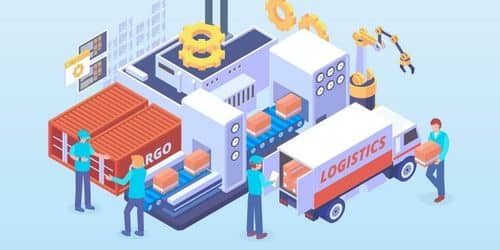Every time you place an order with a retailer, a process occurs in the background until you receive your purchase. This process is known as order management, and it entails keeping track of clients’ orders and managing the stages involved in completing them. The process comprises receiving the order, picking, packing, and delivering the items indicated in the order, and finally tracking them till they are delivered.
Continue reading to learn more about how order management works and how an effective order management system software approach may benefit your organization.
What is Order Management?
Order management is the process of obtaining, managing, and fulfilling customer orders. The order management process begins when an order is placed and finishes when the consumer receives their package.
An order management system (OMS) is a computer process software used for order entry and processing in a variety of businesses. A flawless order is one that is fulfilled to the specifications of the buyer, delivering items as promised at the time of sale.
How Does Order Management Work?
Order management begins when a customer puts in an order and concludes when they receive their goods or service. It enables a company to manage the full fulfillment process, from order collection to inventory and delivery visibility to service availability. The order flow involved can vary depending on the demands of the firm, but a typical order management work process contains three steps:
#1. Placement
The customer places the order using an automated form. A member of the sales staff verifies the information and confirms the order.
#2. Fulfillment
A warehouse employee validates shipment information, prepares an invoice, and fulfills the order – pick, pack, and ship.
#3. Inventory management
Inventory levels are monitored as they fluctuate with corporate demands.
What is an Order Management System?
An order management system (OMS) is a computerized technique to manage the lifecycle of an order.
It keeps track of every step of the order entry, inventory management, fulfillment, and after-sales service process. An OMS provides visibility to both the business and the buyer. Customers can verify when an order will arrive, and organizations can receive near real-time inventory intelligence.
Why Does Your Company Require Precise Order Management?
When you’re bootstrapping business processes with a small team, taking the effort to develop order management system processes and systems can feel like more red tape.
Nevertheless, as your firm grows, you may fall behind if you try to complete every order on your own. Here are just a few of the issues that proper order management has handled.
#1. Avoid overstocking and understocking.
As long as you’re neither overstocking nor understocking, a high inventory turnover ratio might be beneficial.
Overstock means you’re spending money you don’t have on unneeded things that are gathering dust before they hopefully sell one day.
Under-stock and you run the danger of making consumers wait, splitting shipments, or losing easy purchases from clients who were ready to buy immediately but will most likely give that money to your competition instead.
#2. Less order fulfillment errors
When you just mail a few orders per day, it’s simple to prevent fulfillment mistakes.
Simply select the appropriate goods, properly package them, print the shipping label, and mail them.
Now envision your company taking off. Orders are received 24/7 from all over the world via various means. Meanwhile, customers are inundating you with messages questioning their order status, complaining about delivery times, and requesting refunds.
When dealing with this large volume of orders and level of intricacy, it’s only natural to make mistakes. Incorrect products, incorrect addresses, and delayed shipping may all harm the reputation of a growing e-commerce business.
That is why having a simplified order management system in place is critical. Less human mistake equals more automation and synchrony. Things will still go wrong now and then — it’s unavoidable — but you’ll be able to scale your firm without becoming overwhelmed.
#3. Reliable data that enables you to make data-driven decisions
When data is dispersed across various platforms, it is difficult to make sense of it.
Order management solutions consolidate all sales order data in one location, making it easier to examine the data and make data-driven choices.
Real-time issues are also easier to spot using order management systems. because you can watch the entire process from a bird’s eye view rather than as discrete bits.
Making data-driven decisions can save you money in the long term. When order volume is high, even minor inefficiencies can drive supply chain optimizations and have a big impact on your bottom line.
#4. Less time wasted
If you manage an e-commerce firm, you’re probably a creative, entrepreneur, or visionary. Sometimes all three.
But you know what probably isn’t on that list? Expert in e-commerce fulfillment, and justifiably so. Every hour spent addressing fulfillment challenges is an hour that could be spent on more strategic activities like product development or brand growth.
Consider this: Is managing inventory, packaging products, shipping orders, and processing refunds truly the best use of your time? When you’re just starting out, it’s fine to do everything yourself, but there comes a moment when it just doesn’t make sense.
Features of an Order Management System
An OMS System enables firms to manage the whole fulfillment process, from order collection and inventory management to delivery visibility and reporting. These specific order management processes include:
#1.Automated sales process
Track every facet of each sale, including products purchased, payments made, and delivery status, to automate the entire sales process.
#2. Inventory management
Manage your inventory levels by automatically reordering when goods run out. This will assure flawless order fulfillment while also lowering your expenditures.
#3. Management of client relationships
Control the whole customer journey, from lead generation to retention to cross-selling.
#4. Sales Automation
Minimize your work burden by making it simple to order things, communicate with consumers, and handle payments.
#5. Shipping and Receiving
Get visibility into shipments and receipts by accessing real-time information on the progress of each cargo and receiving notifications when concerns develop.
#6. Payment Collection
Collect payments easily with a credit card, PayPal, bank transfer, cash on delivery, or any other payment method.
#7. Document tracking
Keep track of everything connected to your documents as they progress through the various stages of creation. Businesses and manufacturers will be up to date on everything from tracking the status of each document to knowing who has viewed each file.
#8. Advanced Reporting
Evaluate your performance and identify areas for improvement. Top Products, Top Customers, Top Orders, Top Pages, Top Countries, Top Brands, Top Categories, Top Sellers, Top Channels, Top Days, and so on are examples of reports.
#9. Mobile applications
Simple to access your info from anywhere. With mobile apps, businesses may check their sales history and customer lists, order new products, update their product catalog, send emails, create invoices, accept orders, and so on.
What is the Order Management Process?
Payment processing, inventory management, and order tracking are all part of the process.
#1. Payment processing
Receiving, verifying, and processing payments are the main components of the payment processing process. Instead of a cashier, this is handled automatically online by third-party software.
According to a Nielsen Study, credit card fraud cost American businesses $9.47 billion in 2018. And that figure isn’t out of the ordinary. To identify and prevent this form of fraud, order management is critical.
You can avoid authorizing and executing bad orders in the first place by creating a payment confirmation process, which is commonly part of order management systems (OMS) or payment processors.
#2. Order Fulfillment(delivery)
You must fulfill the order after you have validated the payment information. Order fulfillment includes receiving, authorizing, and delivering the order to the ultimate customer.
Your team must select, package, and ship the correct products (in the correct amount) to the correct address. If you do it in-house, you must also route and supervise your delivery drivers.
#3. Inventory management
Inventory management includes monitoring inventory levels in your warehouses and ensuring that inventory counts are correct. The figures must always be current.
Every time an order is placed, you must confirm that the products are available in the requested amounts.
After that, your staff must update the figures on your internal and external sites to avoid selling things that you do not have.
It’s the core of warehouse management and helps you prevent a lot of possible difficulties like overstocking and backorders.
#4. Order Tracking
When you’ve sent the products and updated your databases, it’s time for the next stage in order management: tracking.
If you employ a third-party provider for last-mile delivery, you can trace the order and assure order accuracy.
Nevertheless, if you manage it in-house with your own fleet, you will require a solution to track deliveries and drivers.
The Order Management Cycle
The order management cycle is an end-to-end process that starts when a customer purchases a product and ends with delivery and, in some cases, returns.
To ensure a consistent client experience, the process includes multiple moving pieces, frequently managed by various businesses.
Here’s a quick rundown of the order management cycle.
#1. Placed order
Customers place orders from various locations, at various times, and via every accessible channel.
A multichannel order management system or omnichannel fulfillment solution that can automatically push necessary information (order details, shipping details, delivery address, and so on) from your e-commerce site to your order management system is required to streamline this process on the backend.
#2. Received order
When an order is placed, the information is sent to the fulfillment center, where the order processing process begins.
ShipBob has fulfillment centers in Chicago, Los Angeles, Dallas, and Pennsylvania, allowing retailers to distribute products across the country. When a new order is placed, ShipBob’s order management software selects where to ship it depending on parameters such as available inventory, client delivery address, and so on. This reduces transportation times and delivery costs.
#3. The order is selected
Picking is the process of retrieving product(s) from available inventory and delivering it to a packing station by following a picking list.
Warehouse picking crews, or pickers, are frequently allocated to this activity by 3PLs.
Here is where warehouse management comes into play: how inventory is organized affects how long it takes to fulfill each order.
#4. The order is packaged
When the order is transported to the packing area, it is packaged in a way that reduces the dimensional weight while yet providing adequate protection.
Several 3PLs allow clients to offer their own bespoke packaging in order to provide customers with a unique unboxing experience.
#5. Shipping of the order
Once the item has been packaged, it is dispatched to the purchaser. Some 3PLs have preferred carriers, while others rate shops to ensure their customers get the best delivery prices. Carriers typically pick up the orders directly from the 3PL’s warehouse.
Each order is given a tracking number, which is subsequently shared (manually or automatically, depending on the software) with the consumer, allowing them to check the status of their order at all times.
#6. Delivering the item
The things are then supplied to the end user. But were they the appropriate items? And were they delivered on time?
Your chances are much better if your order management has been flawless throughout.
#7. Following up with the clients
Following up with clients after delivery isn’t just for show.
Maintaining ongoing touch with loyal consumers will assist you in determining why people return to your online store and how you can boost the lifetime value of each customer.
Meanwhile, identifying reoccurring issues can establish a feedback loop that might help your company improve.
#8. Determine what could have been better.
Should you always accept returns and issue refunds?
On the one hand, refunds are an unavoidable element of e-commerce, and they must be handled properly: Consumers who are dissatisfied with the return process are three times more likely to never buy from that store again.
On the other hand, identifying and fixing the root cause of customer discontent might help you avoid future returns and cut logistics costs.
The entire e-commerce logistics process should be analyzed holistically through order management. By tracking important KPIs such as lead times or return rates, as well as qualitative feedback, you can enhance the process to maximize customer happiness while lowering costs.
Software for Order Management
There is no universally applicable order management software. Each solution has its own set of benefits and drawbacks, as well as its own onboarding process and integration possibilities. The optimum fit for your company will be determined by your specific demands and objectives.
Here’s how some of the most popular solutions on the market compare.
#1. Skubana
Skubana is a commerce software that focuses on assisting complex businesses that fulfill orders from different warehouse locations and channels.
The order management software consolidates everything you sell. Their solution also includes detailed data and capabilities for automating practically everything, including purchase order processing. In contrast to alternative solutions such as Brightpearl, Skubana onboarding, and deployment only takes a few weeks.
#2. NetSuite
NetSuite’s SuiteCommerce package has a number of capabilities, including an order management system that can handle orders from a range of channels, such as a physical store, an online store, or even a kiosk.
SuiteCommerce aspires to be a complete commerce platform that does not require integration with other systems.
It is ambitious and powerful, but it may be too much for a tiny e-commerce business, and the learning curve is severe.
#3. ShipStation
ShipStation is a shipping software designed exclusively for online businesses.
It integrates with the majority of marketplaces, shopping carts, and carriers, making it the go-to solution for small e-commerce enterprises looking to do their own fulfillment.
As DIY fulfillment becomes unsustainable, merchants must upgrade to a more scalable solution, such as outsourcing order management and fulfillment to a third-party logistics provider (3PL).
#4. Brightpearl
Brightpearl is a retail management system designed for businesses with more than $1 million in annual revenue.
They offer everything under one roof, from inventory and order management to shipping, a premier POS solution, and even a CRM.
It’s strong but also complicated. Smaller, more nimble organizations would likely benefit from a simpler, less expensive solution.
#5. ShipBob
ShipBob, in contrast to the alternatives mentioned above, provides a complete order fulfillment solution.
They provide e-commerce companies with software that allows them to track inventory, process orders, and access vital data and insights through a single system.
Furthermore, once an order is placed, ShipBob takes care of everything from selection to packaging to shipping and refunds. This enables e-commerce retailers to scale more quickly and economically by focusing on more strategic company operations like product development and brand building.
ShipBob even interfaces directly with Gorgias, the top e-commerce customer service and helpdesk platform, giving firms seamless customer support and shipping data in one place to expedite any post-purchase order inquiries and actions.
What are the Benefits of an Order Management System?
When firms decide to deploy an OMS, they frequently assess their supply chains for bottlenecks and areas that can be addressed. This study can sometimes result in improvements, such as faster fulfillment times. Additional advantages of OMS include better fulfillment across all channels, lower labor costs, and higher sales and margins. Here are some more benefits that can be obtained using OMS platforms.
#1. Improved inventory management
Improved sales visibility allows you to optimize inventory levels to match customer demand while minimizing excess stock. A consolidated view prevents you from missing a sale due to inventories spread across multiple locations. All of these can increase cash flow while also increasing client loyalty and happiness.
#2. Decreased data entry
Because the same information is used throughout the sales and fulfillment process, less data entry is necessary, resulting in fewer errors.
#3. Visibility
Everyone in your organization can access and track order status, which improves customer service. Consumers can also utilize OMS to follow order status.
Analysis OMS dashboards can help you make better decisions by emphasizing sales patterns, tracking key performance indicators, and projecting sales and inventory levels.
What are the Challenges of an Order Management System
Not every OMS software is the same. Even with the most modern software, there may be obstacles to overcome. Here are some common roadblocks and suggestions for overcoming them.
#1. Not Integrated
OMS platforms are most effective when they are linked to other sections of your organization. If your order management system isn’t linked to your CRM, finance management, supply chain, and other software modules, you’re passing on potential efficiency and customer service chances.
#2. Missing Features
The user interface should be clean and concise, providing users with the information they require to execute their work obligations, such as monitoring inventory levels, process returns, and more.
Another key feature is the ability to generate reports on easy-to-understand dashboards, allowing you to see KPIs at a glance. You should also be able to delve further into individual client information to discover things like order history.
Additional features to look for include POS connectivity, a responsive customer service team, and the opportunity to prioritize orders for shipment or in-store pickup.
Inadequate setup
#3. Lack of Configuration
It’s likely that you’ll want to give different employees participating at different stages of the customer lifecycle access to your OMS. Using a platform that allows you to personalize data access, reports, and other information will help you keep data secure while still offering all the tools your employees need to accomplish their jobs well.
- BEST ORDER MANAGEMENT SYSTEMS IN 2023
- OPERATIONS MANAGEMENT SYSTEMS: Types, Features, and Process
- FULFILLMENT CENTER: Meaning And Its Benefit To Small Businesses
- AMAZON AUTOMATION: Overview, Scam, Investments, Store
- WHAT IS AMAZON FBA? How It Works (Detailed Guide!)






